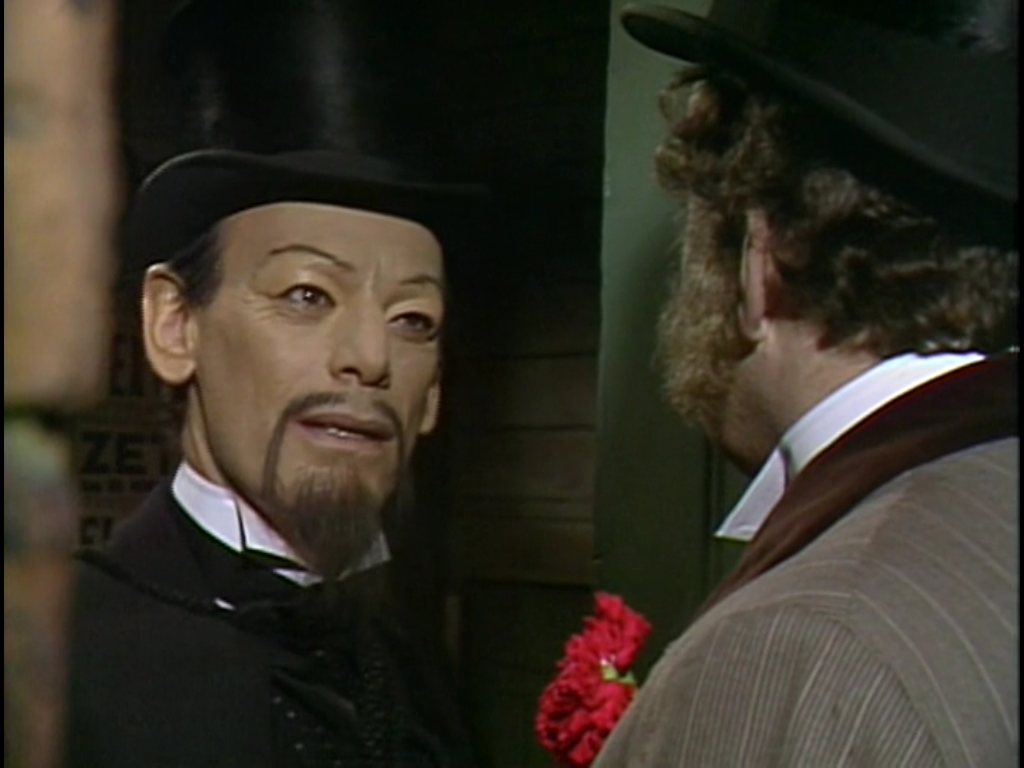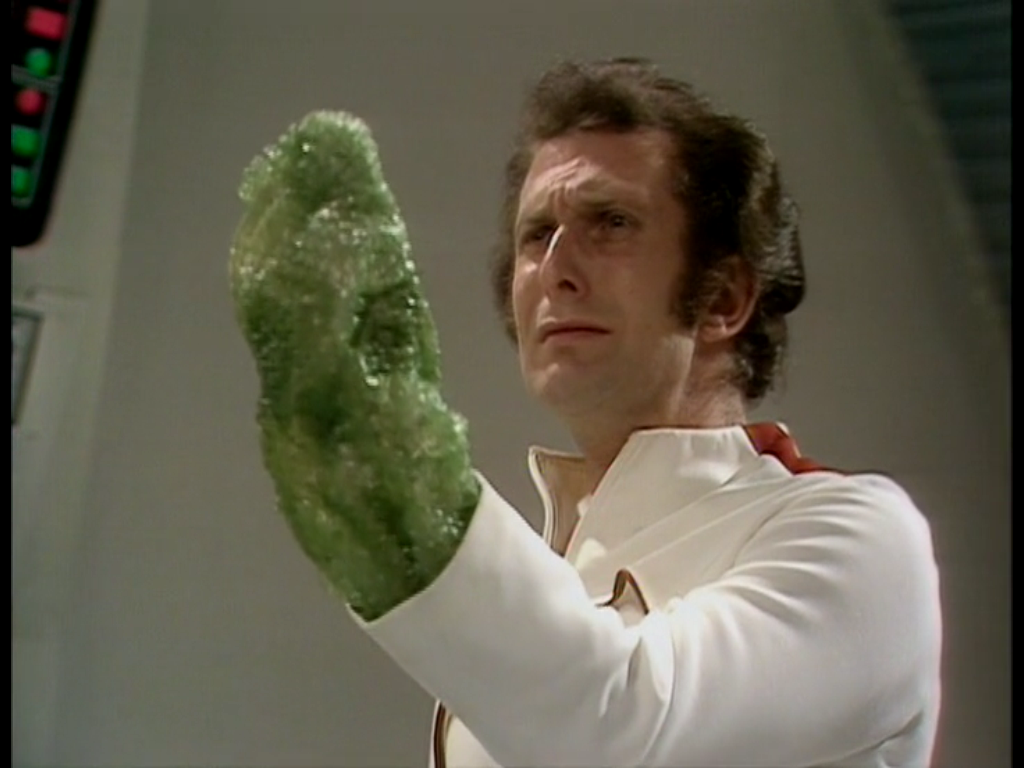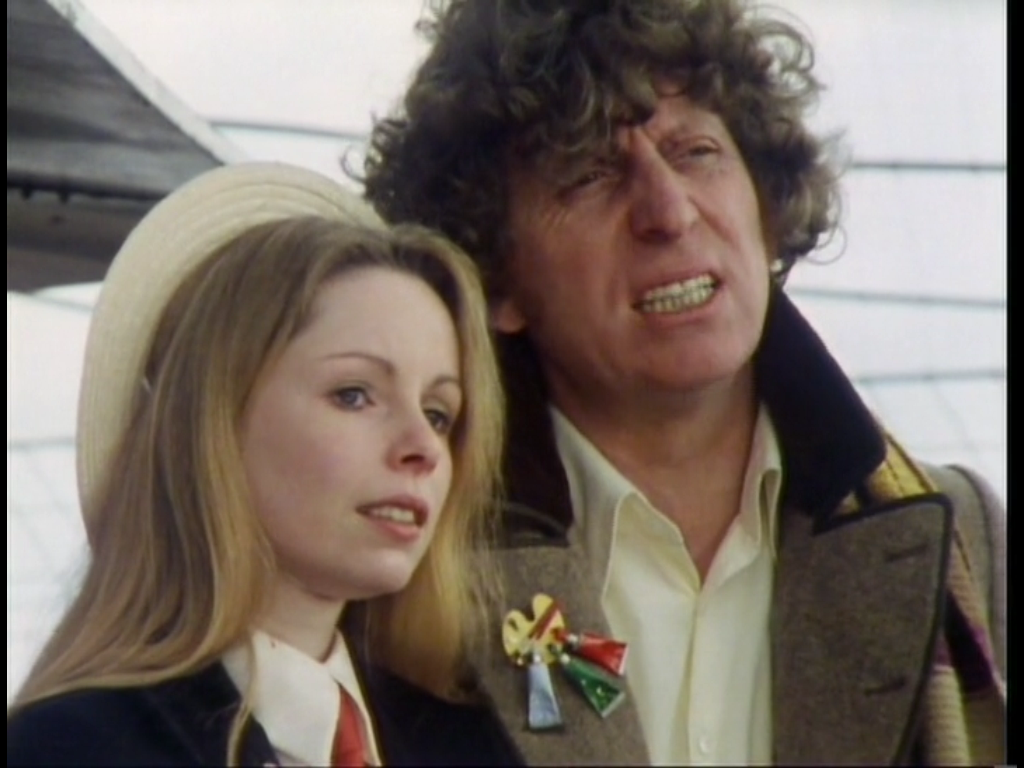What happened to April? I’m still not sure, so let me just be brief: it was probably one of the busiest/craziest months I can remember for me, and I’d love for any future months to take that as a warning that I shouldn’t ever have quite so much going on ever again.
Anyway, April meant this month’s Doctor Who episodes were the Tom Baker era, and in doing so I found myself in a bit of a quandary. Tom Baker was on the show for a record-holding seven years, and went through multiple producers and script editors. He’s also for the original series, the face of the show in the United States. While I was extremely lucky to grow up in an area that had two PBS stations that showed all eras of the show, for many areas all they got were Baker’s stories.
With so many stories to pick from—including some favorites near and dear to my heart—I ended up deciding to start with three stories that most consider “classics” but which I’d never actually seen. (I know, I know. For two of them I read the novelizations growing up and the third… well… I’d seen lots of bits and pieces but never sat down and watched it all the way through.) The end result? Not what I expected.
Baker’s second story, “The Ark in Space” for me locks in the overall tone of producer Peter Hinchcliffe’s era. It’s the first hints we get of the gothic, dark tinged stories that he (and script editor Robert Holmes) dreamed up. Fans of the films Alien and Aliens will see some certain similarities; people in suspended animation in the future, an alien that infects other species to reproduce, a confined area with no easy escape. “The Ark in Space” is a remarkably effective story, one that uses its run-time almost perfectly. This is a story which lets the Doctor and his two companions (Sarah Jane and Harry) interact with just each other and not worry about a supporting cast for the entire first episode and gets away with it wonderfully, after all. With so many “it’ll eat you from the inside” type stories now, I suspect “The Ark in Space” is a bit old hat but at the time I can only imagine how freaked out audiences must have been.
Sarah Jane had been introduced the previous year (and is probably to this day one of the original series’ all-time favorite companions; considering they brought her back for the new series and then gave her a multiple-season spin-off of her own, that’s a reasonable assumption to make) but poor Harry gets an outing here. Harry is a character whom, if I remember correctly, was supposed to be the muscle opposite a much older actor playing the Doctor. Then they hired Baker and oops, Harry was no longer needed. As a result he ends up a bit bumbling to give him something to do, but here’s the thing: he’s got charm thanks to actor Ian Marter. It’s a real shame the character didn’t get to stick around, because I love him.
Some of the effects have been redone for the DVD as an optional extra. Halfway through I switched over to them just to see what the new version of the outer space shots looked like. Are they better? Yes, a thousand times so. Were the old ones bad? Well, no… dated, yes, but not bad. Honestly I’m surprised they didn’t go whole hog and replace the “oh no, he’s got green bubble wrap on his hand” special effect while they were at it. Ultimately unnecessary but inoffensive in terms of a change. But anyway, “The Ark in Space” was a real joy to watch; I’m sorry it took this long.

#091: The Talons of Weng-Chiang
Bizarrely I just realized that both this and “The Ark in Space” were written by the same person (Robert Holmes), and that this also closed out the Hinchcliffe producer era. (Holmes would stay on for a few more stories as script editor under incoming producer Graham Williams.) But where “The Ark in Space” was as good as everyone claimed, “The Talons of Weng-Chiang” is anything but.
First let’s tackle the elephant in the room. The main Chinese character—Li H’sen Chang—is played by a Caucasian man in yellow face. Is it offensive? Yes, yes it is. Director David Maloney, when asked about the casting of John Bennett in the role, has said they couldn’t find a qualified Asian actor but I find that incredibly hard to believe. Then again, all the other Chinese characters are either part of the Tong or are coolies, so maybe actors were steering clear? At any rate, it’s truly offensive in this day and age. Lots of heavy-accented mispronounced words, I think at one point the word “inscrutable” is used, and in general it’s every bad stereotype piled on. So for that aspect alone, it fails miserably.
But even if you ignore that (which many fans have and still do), it’s not a very good story. At six parts it overstays its welcome and just plain drags. Lots of “we didn’t do it / yes you did” scenes to pad out the start, and then massive run-arounds in the later episodes. And not to mock bad production values, but the giant rat is one of the more laughable disasters in the history of the show. There’s no reason for this episode to last as long as it does, and it overstayed its welcome with me.
There is one high point, though, and that’s companion Leela (a “noble savage” that the Doctor is educating) interacting with Professor Litefoot. There’s more than just an Eliza Doolittle relationship here; the moment where after Leela is chowing down on the roast by picking up a piece and chewing and he does the same (as to not embarrass his guest) is adorable. If Leela had left at the end of this story to stay with Professor Litefoot I’d have been just fine with that end result.
Ultimately, I’m a little befuddled on why this is regarded so highly. It has big ambitions but it fails to come together in any satisfactory manner for me.
Last but not least is “City of Death,” which is notable in part for being co-written by then script editor Douglas Adams, and also for its extensive location filming in Paris. It was the first big foreign location shoot for the show, and you can tell the show is reveling in it; lots of episodes of Baker and actress Lalla Ward running through its streets and seeing its sights. Charlie watched this episode with me and at one point he remarked that we were really watching a tourism video from the government of France.
The story itself is fun, involving hiccups in time, seven Mona Lisas, and characters popping up all through time where they shouldn’t be. Watching the Doctor, companion Romana (a female Time Lord that is in many ways the Doctor’s equal), and villain Scaroth (played by Julian Glover) interact with one another is fast-paced and witty, and there are so many little dialogue gems it would be impossible to count them all.
Here’s the thing about “City of Death.” People often remember it for the cameos (John Cleese and Eleanor Bron), or guest star Julian Glover, or the Paris location work, or the “can I hit it?” guest character of Duggan. But there’s no one thing that makes “City of Death” fun, it’s that everything works together in near perfect unison. That’s all the more surprising when you look at “City of Death” in context of the rest of its season. It was producer Williams’ final season, and generally speaking it’s a disaster. “City of Death” not only stands out as the best for that year, but it’s one you can hold up against most of the Baker era and it does well. In some ways it’s slight and silly, but there’s such a pleasant charm to “City of Death” that I don’t care. It had me smiling from start to finish, and it was a lovely experience and doubly so to share with Charlie.
So, three “classics” where two really were as good as everyone said, and one where I’m baffled with the love displayed towards it. That’s not a bad hit percentage, and a fun way to tackle the Tom Baker era in general. (It’s also the last one I could do this sort of selection with, since I’ve seen all the episodes for the remaining eras ahead.)
Next up? Peter Davison’s three years. This should be good.


#DoctorWho 50 Years of Doctor Who: Tom Baker – Greg McElhatton http://t.co/HohngPh5M7
David Robson liked this on Facebook.
Greg McElhatton: 50 Years of Doctor Who: Tom Baker http://t.co/IohBFGnjhZ
RT @SFWAauthors: Greg McElhatton: 50 Years of Doctor Who: Tom Baker http://t.co/IohBFGnjhZ
@gregmce I believe there is a subset of Doctor Who fans for whom all Leela episodes are among the best of the T Baker era. Quality no issue.
We just finished watching Pyramids of Mars. But Logopolis is still my favorite.
I’m still somewhat in love with “Talons”, the script for which is so dense and witty that, after multiple viewings, I’m still picking up great lines of dialogue that I missed the last few times. Though you can say that about most of Baker’s Hinchcliffe-era stories!
Old Who is so much geekier/better than New Who.
Jason A. Miller liked this on Facebook.
Sarah McGiverin liked this on Facebook.
Caroline Small liked this on Facebook.
Tim Tucker liked this on Facebook.
Beth Forster liked this on Facebook.
i enjoyed these reflections–of these three my favorite is definitely CoD. as for me, effective today i suspended my 50th marathon because of the situation in cardiff.
I’m shocked there are stories you’ve never seen! Ark in Space and Talons are two of my favourites but I’ve never enjoyed City of Death.
RT @gregmce: Blog Post: 50 Years of Doctor Who: Tom Baker http://t.co/KDfRxRIRr2
Beth Forster liked this on Facebook.
Jason A. Miller liked this on Facebook.
Caroline Small liked this on Facebook.
Tim Tucker liked this on Facebook.
David Robson liked this on Facebook.